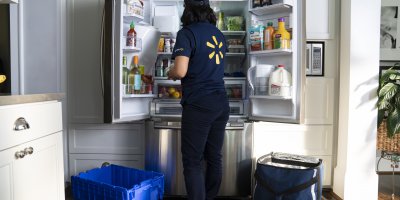
Tomorrow’s grocers will be competing with restaurants. Source: Shutterstock
Auchan China Chief talks about Sun Art and the future of grocers
NOBODY really talks about the impact of digital on the future of grocers.
The conversation about how technology is disrupting the shopping habits of consumers is usually focused on the growing challenges for retailers in the digital age and the seemingly vast opportunities for e-commerce companies.
Grocers, although equally affected by technology, don’t seem to be in too much trouble. Not yet, at least.
According to French retail group Auchan China Chairman Ludovic Holinier, the reality is that the market share of online grocery retail is still quite negligible — even in China, where more than 90 percent of the business is still brick and mortar.
“In ten years, I think the penetration of online will be around 30 percent. But stores won’t go away,” Holinier told McKinsey recently.
“Three or four years ago, everyone was convinced that the pure-play online model would be the winning model for grocery and fresh food all over the world—but that’s now been proved wrong, because nobody is making money delivering groceries and fresh food from big warehouses.
“[Alibaba’s] Hema, or Freshippo, proved that “new retail” has to be a mix of in-store and online.”
In China, Auchan is part owner of the Sun Art brand — the country’s largest hypermarket chain — along with Alibaba, operating more than 400 hypermarkets under the Auchan and RT-Mart banners, with support from more than 140,000 employees.
To prepare for the digital age, Sun Art has been refining its online-to-offline (O2O) offering and has recently rolled out a new one-hour delivery service across all stores, delighting customers and providing them with more convenience.
However, the brand understands that its digital journey has just started.
“We will obviously have to build strong digital capabilities. And as we monitor customer behavior online and develop a deeper understanding of our customers, we need to bring that knowledge into the store—for example, through a personalized in-store experience and personalized offers.
“A key point is that our digital capabilities must be national or global, but our in-store capabilities must be reinforced locally. We need to find ways to empower store directors to adapt locally so that our stores become more relevant to their local communities.
“If we build digital capabilities to improve operations—including automating and streamlining our back-office processes—we will free up the time and spirit and mind-set of our employees to ‘think local’ and focus on taking care of customers.”
“Restaurants will become the main competitors of grocers”
In discussing the future of grocers, Holinier made an interesting observation.
“Another thing we’ll see in China is that restaurants will become the main competitors of grocers.
“Already, more than 21 million meals are delivered every day in China, and the habits of Chinese customers are changing. There are even new residential developments being built in which the apartments have no kitchens.”
According to the Auchan China Chairman, grocers will need to somehow figure out how to cater to the changing needs of customers.
“In the coming years, we will need to completely redefine the company mission. As a retailer, we were about selling products. Going forward, we need to be about feeding people,” explained Holinier.
This trend is probably why Auchan has been piloting in-store restaurants and pushing its catering and delicatessen categories in recent times.
Although not so pronounced, the shift towards ordering meals instead of cooking is something we see across the globe.
UK’s Deliveroo, for example, which invested significantly in its APAC operations to grow its rider and restaurant partnerships, recently reported nearly 70 percent growth in revenues (2017 v 2018 figures) in Singapore.
Globally, based on 2016 and 2017 figures, Deliveroo’s sales seem to have grown 116 percent, and analysts are optimistic about the company’s future.
Holinier’s observations, therefore, are something for grocers to think about — their future might be hanging in the balance if they don’t plan ahead.
READ MORE
- Ethical AI: The renewed importance of safeguarding data and customer privacy in Generative AI applications
- How Japan balances AI-driven opportunities with cybersecurity needs
- Deploying SASE: Benchmarking your approach
- Insurance everywhere all at once: the digital transformation of the APAC insurance industry
- Google parent Alphabet eyes HubSpot: A potential acquisition shaping the future of CRM






